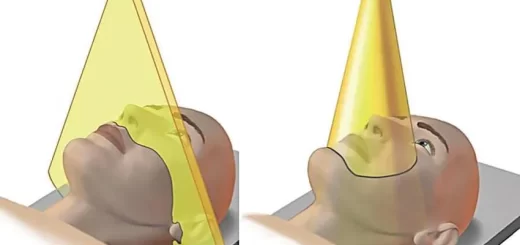Uses of the concave mirror and the convex mirror in our daily life
Concave mirror is a converging mirror that is used for many purposes, It is used as a torch to reflect light, It is used in aircraft landing at airports to guide the aeroplanes, It is used in shaving to get an enlarged and erect image of the face. Convex mirrors are used in security and surveillance systems because they provide a wide field of view, This makes them ideal for monitoring large areas, such as parking lots, stores, and public spaces.
Uses of the concave mirror
Concave mirrors are often used where magnification is needed, such as in shaving mirrors, makeup mirrors, and microscopes. They can also be used to focus light, as in headlights and searchlights.
Concave mirror is used in front lights of cars to reflect the light, It is used in marine lighthouses that are found at marine ports and at airports to guide the ships. Concave mirrors are used in medical devices such as laser surgery devices.
Concave mirror is used in solar ovens and solar furnaces to collect a large amount of solar energy in the focus of the mirror for cooking food, heating water, recharging power backups, or melting metals respectively. You can use a concave mirror to focus sunlight onto a piece of paper and start a fire.
Concave mirrors are used in satellite dishes, They are used in telescopes, and microscopes to magnify distant objects and tiny objects, respectively. Concave mirrors are used in electron microscopes and magnifying glasses, They are used in visual bomb detectors and they are used in the flashlight mirror of the camera.
Dentists and ENT doctors use them to obtain a larger image than the original of the teeth, ear, skin, etc. Concave mirrors are used by dentists to magnify their patients’ teeth, making it easier to examine and treat them. Concave mirrors are used in medical devices, such as ophthalmoscopes, and laryngoscopes, to allow doctors to examine the inside of the eye and throat.
Concave mirrors are often used in shaving mirrors and magnifying glasses. This is because they can magnify the image of your face, making it easier to see what you are doing. You can take funny photos of yourself with a distorted face in a concave mirror, or of tiny objects magnified under a magnifying glass.
You can use a concave mirror to make an object appear larger than it is, or to create a reflection that is upside down or backwards. You can use this to your advantage to take unique and creative photos. you could take a photo of a small toy car that looks like a real car in the reflection.
You can use a concave mirror to create a reflection that is upside down or backwards. You can use convex and concave mirrors together to create optical illusions. you could place a convex mirror in front of a concave mirror to create a reflection that is infinitely repeated.
You can place a concave mirror in your backyard and use it to reflect sunlight onto a tree to create a shadow. you could place the mirror on the ground and stand over it to make your legs look longer. The ancient Egyptians invented the first concave mirror.
Concave mirrors are used in headlights and flashlights to focus the light beam, making it brighter and more visible. Concave mirrors are used in makeup mirrors to magnify the user’s face, making it easier to apply makeup. Concave mirrors are used in security systems to provide a magnified view of a specific area.
Concave mirrors reflect light in a parallel beam, which helps to illuminate the road ahead. Concave mirrors can be used to concentrate sunlight onto solar panels, making them more efficient at generating electricity.
Real image and Virtual image
The real image is formed as a result of the intersection of the reflected light rays, It can be received on a screen and it is always inverted.
The virtual image is formed as a result of the intersection of the reflected light rays extensions, It can not be received on a screen and it is always erect (upright).
The focus of the concave mirror
The focus of the concave mirror is produced due to the collection of the reflected rays emitted from a far object such as the sun, The rays after being reflected collect in one lit point which is called the focus of the mirror that can be received on the screen.
The distance between the focus of the mirror and the pole of the mirror = ½ the radius of mirror curvature and it is called the focal length of the mirror.
When the incident light ray is parallel to the principal axis, It reflects passing through the focus, When the incident light ray passes through the focus, It reflects parallel to the principal axis, When the incident light ray passes through the center of curvature, It reflects back on itself.
Cases of formation of the images by the concave mirror
When the position of the object is very far, the position of the image is at the focus, The image is real and very tiny (dot).
The object is at a distance greater than the radius of curvature (after the center of curvature), The image is at a distance greater than the focal length but less than the double of focal length (between the focus and the curvature), The image is real, inverted and diminished (small).
When the object is at the center of curvature (at a distance equals the radius of curvature), The image will be at the curvature center, The image will real, inverted, and equal to the object.
When the object is between the center of curvature and the focus (at a distance more than the focal length but less than the radius of curvature), The image is after the center of curvature (at a distance greater than the radius of curvature), The image is real, inverted and enlarged (magnified).
When the object is between the focus and the pole (at a distance less than the focal length, The image is behind the mirror), The image is virtual, upright ( erect ), and magnified.
When the object is at the focus, No image is formed, The image is at infinity where the rays penetrate as parallel.
Uses of the convex mirror
Convex mirrors are often used where a wide field of view is needed, such as in rear-view mirrors and security mirrors. They also produce diminished images, which can be useful for seeing large areas in a small space.
Convex mirror is used as a side-view mirror on the passenger’s side of a car because it forms an erect and smaller image of the way behind the car. Convex mirrors provide a wider field of view than flat mirrors, making them safer for driving. You can take fun photos of yourself and your passengers in the convex mirror, or of the cars and scenery behind you.
Convex mirror is suitable for convenience shops and big supermarkets and any other corner that needs anti-thief, It is used in turning off the road and parking. Convex mirrors are also used in security mirrors in stores to deter shoplifting by giving employees a wider view of the store and helping prevent theft.
Convex mirrors are used inside buildings, They are also used in making lenses of sunglasses, They are used in the magnifying glass, They are used in securities and they are used in telescopes.
They can be used as street light reflectors because they can spread the light over a bigger area, They are put on the corners of roads so that you can see any cars coming to avoid collisions and they are used as ceiling dome mirrors. Convex mirrors help drivers see oncoming traffic from around corners or other blind spots.
Convex mirrors are spherical mirrors, they give a virtual and erect image, and the image by a convex mirror can’t be captured on a screen, Side-view mirrors in vehicles, and driveways use a convex mirror. Convex mirrors are used at intersections and other dangerous areas of the road to help drivers see oncoming traffic.
Convex mirrors are used in amusement parks to create fun and distorted images. Convex mirrors are used in vending machines to allow customers to see the products inside without having to open the machine. Convex mirrors are used in art galleries to allow visitors to see a larger area of the gallery without having to move around as much.
Properties of the formed image by the convex mirror
Wherever the position of the object in front of the convex mirror, the image is smaller than the object, It is upright (erect), It is virtual (not received on a screen).
You can subscribe to Science Online on YouTube from this link: Science Online
You can download Science Online application on Google Play from this link: Science online Apps on Google Play
Lenses use, types, Convex lens, Concave lens, Vision defects, Contact lenses & Cataract
Properties of the formed images by the convex lens and concave lens
Laws of light reflection, Plane mirrors, Spherical mirrors, Concave mirror & Convex mirror
Spherical mirror use, Properties of Images formed by Concave mirror & Convex mirror




Not bad
Thank you very much
please add some defination to it
There are many definition in these articles , You can read them
The properties of the image formed by a plane mirror
What are the spherical mirrors ?
tnq very much it helped me very well thank you!!!!
You are welcome
Thank you very much for your comment
pretty legit bruh im awesome
Thank you for your comment
this was used at my school
good stuff
Thank you very much
Nice
Thank you very much
Thx u guyz..
You are welcome
Thank you very much for your comment
Thankuu u so much because of u without spending my time I easily got uses of mirrors
You are welcome
Do your best to be the best
Thank you very much for your comment
Thank you
You are welcome
Thanx
You are welcome
Thank you for your comment
Very useful!
Thank you very much for your comment
thanks alot
Good explanation
Thank you very much for your comment
Thnks for helping me?. Gud explanation.?
You are welcome
Thank you very much for your comment
thanks for Help me
You are welcome
Thank you very much for your comment
very helpful for me…. nice explaination
Thank you very much for your comment
thanks it helped me
You are welcome
Thank you for your comment
Thanks for helping me out of the canfusion ????????????
You are welcome
Thank you very much for your comment
good
Very very good to education thank u for giving this information
You are welcome
Thank you very much for your comment
thanks for this information
You are welcome
Thank very much for your comment
it is helpful
Thank you very much
Excellent article…very useful too.
Thank you very much
thanks,this was my home work
You are welcome
very nice! can you tell about spherical lenses too?
it will be very useful for my homework
Thank you very much , you can read this article about What are the spherical mirrors? & Some concepts related to spherical mirrors
Thanks
You are welcome
Thanks
You are welcome
Not really clear, but it was useful in some way. Thank you
It was the matter I was searching for thanks for providing this😊
You are welcome
It is useful thank you
You are welcome
it is good
Thank you!!!
You are welcome
IT HELPED ME A LOT THANK YOU VERY MUCH
You are welcome
Thank you
You are welcome
Thank you so much for the answers
You are welcome
Not bad
Thanks a lot madam / sir
You are welcome
Thank you for your comment
Impressive Stuff.
Keep it up!
Thank you very much for your comment
keep it up, thank you